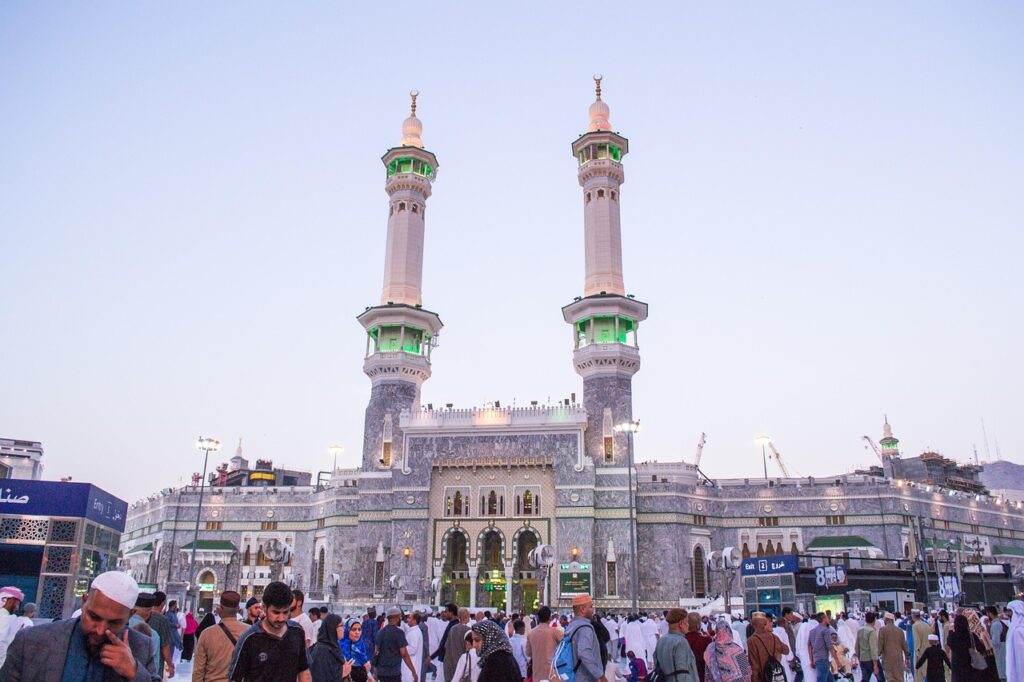Traveling to spiritual sites is more than just a journey of the body—it’s a journey of the soul. Across the globe, sacred destinations offer a rare opportunity to experience the union of faith, history, and living tradition. These religious sites are not just places of worship; they are cultural landmarks where rituals, architecture, festivals, and daily life come together in harmony.
1. Varanasi, India
Situated on the banks of the sacred Ganges River, Varanasi is one of the oldest continuously inhabited cities in the world. A hub of Hindu spirituality, it offers deep insight into life, death, and rebirth. Here, culture and religion converge in every alley, temple, and ghat (riverbank steps). The Ganga Aarti ceremony, performed each evening, draws pilgrims and travelers from around the world to witness the spiritual rhythm of the city.
2. Jerusalem, Israel
Jerusalem holds profound significance for Judaism, Christianity, and Islam. The city is a living museum of ancient architecture, holy texts, and millennia of faith. Visitors can walk through the Old City to explore the Western Wall, the Church of the Holy Sepulchre, and the Al-Aqsa Mosque—all within proximity. The cultural diversity of Jerusalem adds another layer to its sacred identity.
3. Kyoto, Japan
Once the imperial capital, Kyoto is home to over 1,600 Buddhist temples and 400 Shinto shrines. These include iconic sites like Fushimi Inari-taisha with its thousand red torii gates, and the serene Zen gardens of Ryoan-ji. Cultural values are reflected in every ritual, tea ceremony, and traditional kimono-clad pilgrimage that takes place throughout the city.
4. Lalibela, Ethiopia
Lalibela is a center of Ethiopian Orthodox Christianity and is famous for its monolithic rock-hewn churches. These architectural wonders, carved directly into the ground, are still active places of worship. Pilgrims walk for days through the highlands to reach this holy site, where centuries-old liturgies are still performed in Ge’ez, an ancient liturgical language.
5. Mecca, Saudi Arabia
As the holiest city in Islam, Mecca is the destination of the Hajj pilgrimage, one of the five pillars of Islam. Millions gather annually in an extraordinary expression of unity and devotion. While only Muslims may enter Mecca, its global spiritual significance makes it a cornerstone of religious and cultural understanding.
These are just a few examples of religious destinations with deep cultural tapestry. They serve not only as spiritual touchstones but also as custodians of culture, preserving languages, rituals, festivals, music, and architectural traditions.
Whether you’re a believer or a curious traveler, visiting these places offers more than a moment of awe—it offers a chance to witness how the sacred and the cultural merge to shape identity, community, and history.
6. Lumbini, Nepal
Lumbini, nestled in the Terai plains of southern Nepal, is renowned as the birthplace of Siddhartha Gautama, who later became known as the Buddha. This sacred location holds immense importance in Buddhism and attracts pilgrims, monks, and spiritual seekers from all corners of the world. The tranquil environment of Lumbini offers a meditative escape from modern life, making it a deeply spiritual haven. The area is home to a sprawling monastic zone, where Buddhist communities from countries like Thailand, China, Japan, and Germany have built exquisite temples and monasteries, each reflecting the unique artistic, architectural, and cultural expressions of their homeland.
The central attraction, the Maya Devi Temple, marks the exact spot where Queen Maya gave birth to the Buddha more than 2,600 years ago. Surrounding the temple are ancient ruins, stone inscriptions, and sacred gardens, offering insight into centuries of devotion. Visitors can also spend time at the sacred Bodhi tree, where prayers are tied with colorful cloths, and the tranquil Ashoka Pillar, erected by Emperor Ashoka in the 3rd century BCE to honor the Buddha’s birthplace. Altogether, Lumbini is not just a pilgrimage site—it is a living testament to religious harmony, peace, and cultural continuity that transcends borders.
7. Fez, Morocco
Fez, one of Morocco’s oldest imperial cities, is a vibrant cultural and spiritual epicenter steeped in centuries of religious scholarship and artistic achievement. Revered as the soul of Morocco, Fez is a city where ancient traditions thrive alongside daily life. Its beating heart is the University of Al Quaraouiyine, founded in 859 AD and widely recognized as the world’s oldest continuously operating university. This institution has long been a hub for Islamic theology, science, and literature, drawing scholars from across the Islamic world.
The city’s famous medina (Fes el-Bali) is a UNESCO World Heritage Site, a labyrinth of over 9,000 alleys teeming with history, life, and spiritual energy. Within its maze-like streets, you’ll find intricately designed mosques, madrasas (Islamic schools), Sufi shrines, and bustling souks where centuries-old artisan crafts—like leather tanning, mosaic tilework, and embroidery—are still practiced today. Fez also hosts vibrant religious festivals and is known for its preservation of Andalusian-Arabic music and spiritual poetry. Altogether, Fez is not merely a historical city—it is a living museum of Moroccan culture, deeply rooted in spiritual practices and enriched with an artistic soul that continues to inspire and educate.
8. Mont Saint-Michel, France
Perched on a rocky islet in the tidal bay of Normandy, Mont Saint-Michel is one of Europe’s most iconic spiritual landmarks and architectural marvels. This stunning medieval abbey rises dramatically from the sea, often shrouded in mist, creating an otherworldly and almost mystical impression. For over a thousand years, it has been a revered pilgrimage site dedicated to Saint Michael the Archangel. The abbey’s Gothic spires, winding stairways, and cloisters offer a glimpse into France’s monastic past and religious devotion.
Pilgrims and travelers alike are drawn to Mont Saint-Michel not only for its religious significance but also for its breathtaking surroundings. During high tide, the island appears to float on water; during low tide, a vast stretch of sand opens up, allowing visitors to walk the ancient pilgrimage path. Inside the abbey, echoes of Gregorian chants and stone-carved relics speak of centuries of worship and solitude. Its preservation over the centuries reflects the resilience of French spiritual life and architectural genius. Today, Mont Saint-Michel continues to welcome visitors as both a religious sanctuary and a cultural treasure where history, faith, and natural beauty converge.
9. Amritsar, India
Amritsar, located in the northern Indian state of Punjab, is a spiritual and cultural beacon for millions around the world. The city’s centerpiece, the Golden Temple (Harmandir Sahib), stands as the most sacred site in Sikhism. Covered in gold leaf and surrounded by the sacred Amrit Sarovar (pool of nectar), the temple’s brilliance is mirrored in the waters below, creating a visually and spiritually awe-inspiring experience. Day and night, the temple complex is filled with the sounds of prayer, the rhythm of sacred hymns (kirtan), and the scent of incense.
Amritsar is also known for its unparalleled sense of community and equality, most visibly demonstrated through the Langar, a massive free kitchen that serves meals to over 100,000 people daily, regardless of religion, background, or social status. This act of collective service (seva) is a core tenet of Sikh philosophy. Beyond its religious role, Amritsar is a cultural powerhouse—rich in Punjabi dance, music, and culinary heritage. Sites like the Jallianwala Bagh and Partition Museum also reflect the city’s historical depth. Amritsar truly embodies the spirit of hospitality, spiritual devotion, and cultural pride.
10. Santiago de Compostela, Spain
Tucked away in northwestern Spain, Santiago de Compostela is a destination of deep religious and historical significance. It is the culminating point of the Camino de Santiago, an ancient Christian pilgrimage route that winds through scenic landscapes, rustic villages, and medieval towns across Europe. For over a millennium, pilgrims have journeyed on foot, horseback, and bike—often for hundreds of kilometers—to reach the city’s magnificent cathedral, believed to house the remains of St. James the Apostle, one of Jesus’s original disciples.
The city itself is a masterpiece of Romanesque, Gothic, and Baroque architecture. The cathedral square pulses with life as weary travelers celebrate the completion of their spiritual journey. But Santiago de Compostela is more than just a pilgrimage site—it’s a cultural treasure trove, offering vibrant Galician traditions, local cuisine like pulpo a la gallega, and folk music echoing from stone alleys. Throughout the year, the city hosts numerous festivals that blend religious observance with community celebration. It’s a powerful example of how faith, culture, and resilience come together to create a destination that’s both transformative and timeless.
Conclusion:
Religious destinations enriched with cultural values offer more than just spiritual reflection—they provide a gateway into the soul of civilizations. From the riverfront rituals of Varanasi to the sacred silence of Kyoto’s temples, these places embody traditions passed down through generations. They remind us that faith and culture are deeply intertwined, shaping how communities live, celebrate, and preserve their heritage. Whether you are on a personal pilgrimage or a cultural quest, exploring religious destinations allows for meaningful travel experiences that stay with you long after the journey ends


